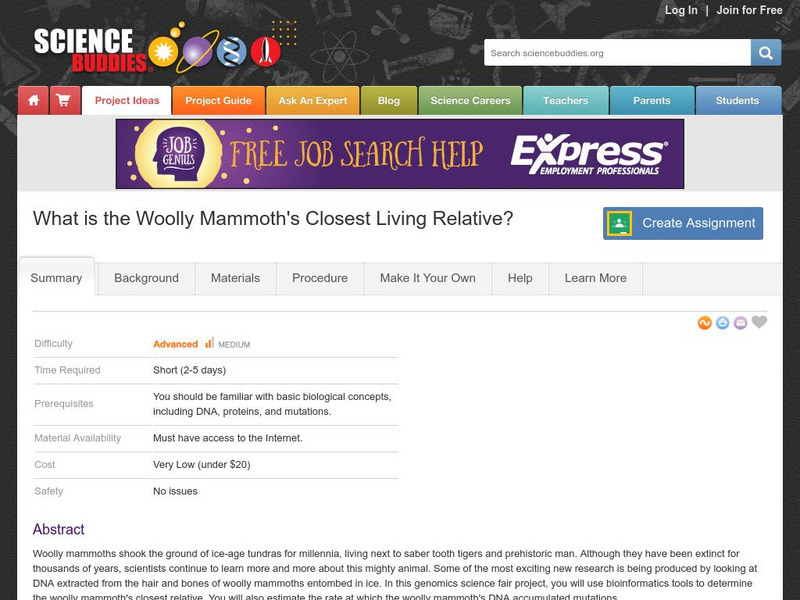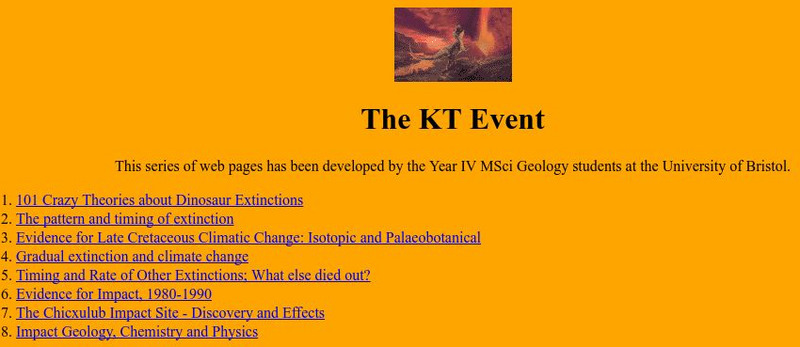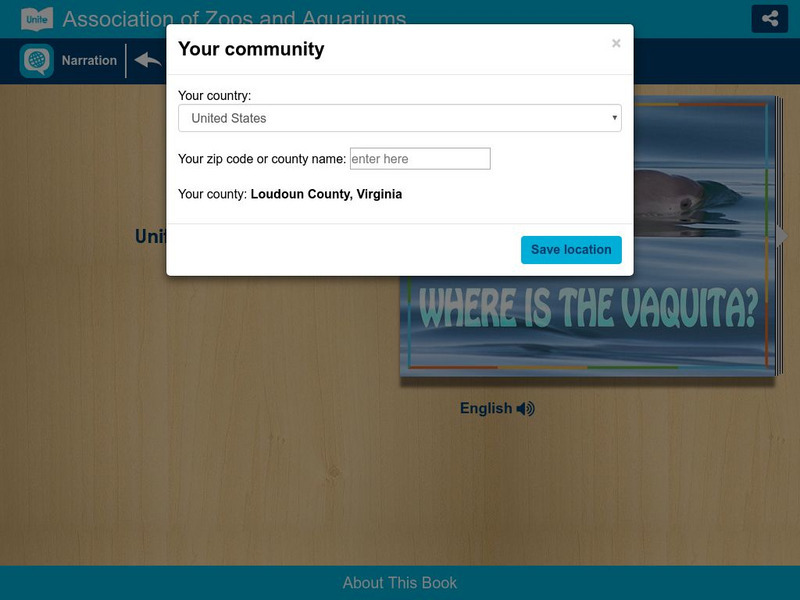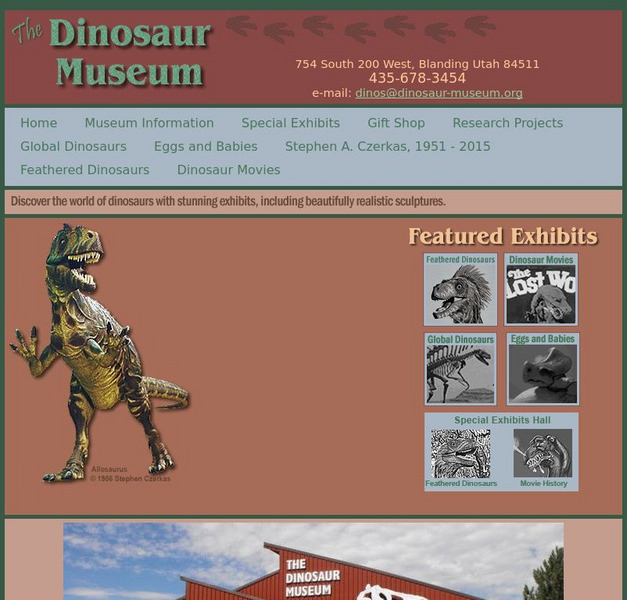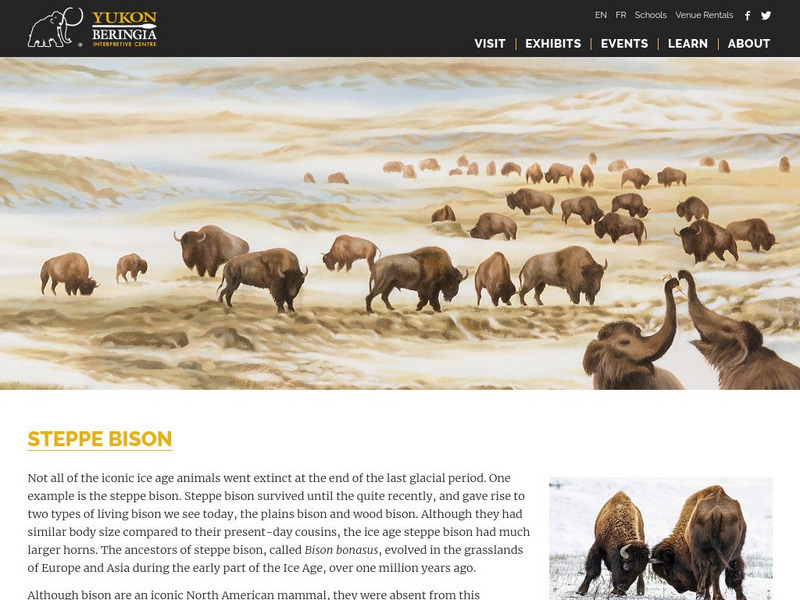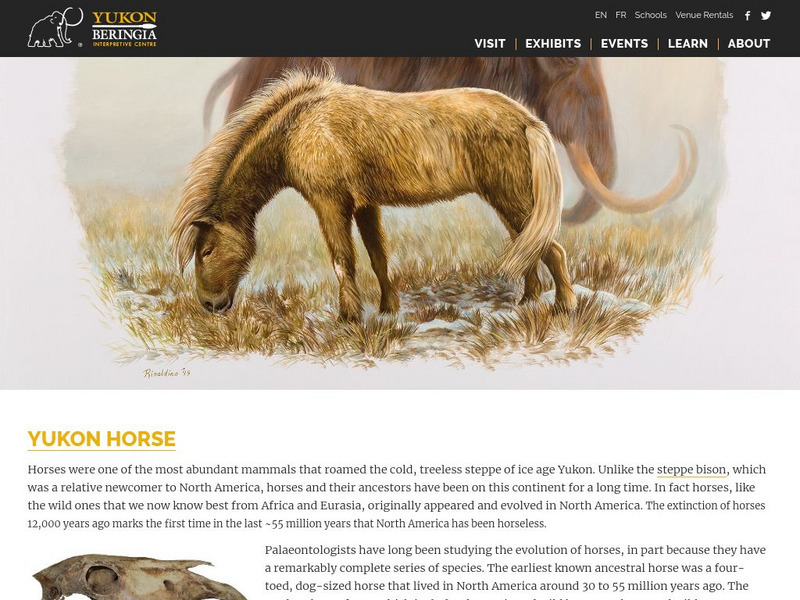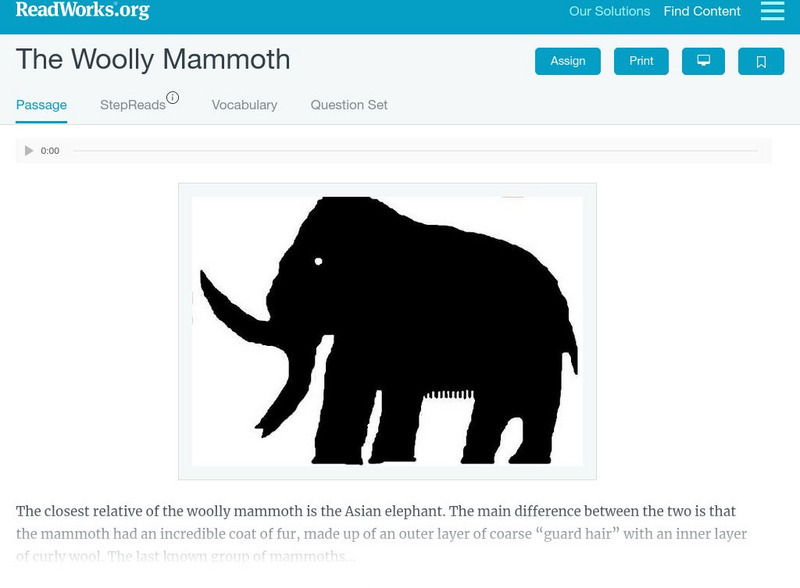Science Buddies
Science Buddies: What Is the Woolly Mammoth's Closest Living Relative?
Although Woolly Mammoths have been extinct for thousands of years, scientists continue to learn more and more about this mighty animal. Some of the most exciting new research is being produced by looking at DNA extracted from the hair...
Other
University of Bristol: The Kt Event
This dinosaur site, containing eight different sections, includes topics such as: 101 crazy theories about dinosaur extinction, the pattern and timing of extinction, evidence for late cretaceous climatic change, gradual extinction and...
Other
Black Hills Institute of Geological Research: Unearthing T. Rex
Follow the steps of paleontologists as they excavate Tyrannosaurus bones. This project took place in 2004 but there is plenty of useful information on the website for learning more about the T. Rex. Such as, how do you tell a male from a...
TeachEngineering
Teach Engineering: Extinction Prevention via Engineering
Species extinction is happening at an alarming rate according to scientists. In this lesson, learners are asked to consider why extinction is a problem that we should concern us. They are taught that destruction of habitat is the main...
Unite for Literacy
Unite for Literacy: Saving Animals From Extinction: Where Is the Vaquita?
Learn some facts about the vaquita, a type of porpoise that is endangered. Book includes audio narration in English and Spanish with text in English.
Better Lesson
Better Lesson: Birds Help Their Young Survive (Bald Eagles)
Birds protect their young in some cool ways! See how our national bird cares for its chicks. Students will read a National Geographic article about Eagles becoming extinct, and will watch a video on Iowa Bald Eagle cameras. Students will...
Lawrence Berkeley National Laboratory
Berkeley Lab: The Fruitful & Inventive Mind of Scientist Luis Alvarez
This article, reprinted from the fall 1979 LBL News Magazine, was written about Dr. Luis Alvarez and his part in the study of geological sediments and the great extinctions.
Society for Science and the Public
Science News for Students: Glimpse of a Legendary Woodpecker
A bird that was thought to be extinct has recently been spotted in Arkansas. The ivory-billed woodpecker was thought to have been killed off due to loss of habitat. Researchers are now raising money to help save this rare bird.
TED Talks
Ted: Ted Ed: When Will the Next Mass Extinction Occur?
Borths, D'Emic, and Pritchard give a quick history of mass extinctions. [5:01]
SEDL
Sedl: Extinction
This second lesson in a course on dinosaurs is devoted to extinction. There are group activities, discussion of the idea, and a way to assess what the students have learned.
National Center for Ecological Analysis and Synthesis, University of California Santa Barbara
Kids Do Ecology: Endangered Species and Conservation Biology
Find out about conservation biology as it relates to endangered and threatened species. Learn about the factors contributing to the loss of species and what efforts have helped bring some animals back form the brink of extinction.
Other
The Dinosaur Museum
The Dinosaur Museum is located in Blanding, Utah. Use this site to learn all about the exhibits and dinosaur information.
Other
Yukon Beringia Interpretive Centre: Research: Giant Short Faced Bear
Uncover discoveries from the past by learning about the prehistoric giant short-faced bear. Includes information about the time period, physical characteristics, fossil specimens, feeding habits, and habitat.
Other
Hvpm: Mass Extinctions
An overview of the mass extinctions throughout earth history. Each mass extinction has a link to its own page with a list of its possible causes and the species that were most affected.
Other
Yukon Beringia Interpretive Centre: Research: Jefferson's Ground Sloth
Uncover discoveries from the past by learning about the prehistoric Jefferson's ground sloth. Includes information about the time period, physical characteristics, fossil specimens, feeding habits, and habitat.
Other
Yukon Beringia Interpretive Centre: Research: American Mastadon
Uncover discoveries from the past by learning about the prehistoric American mastodon. Includes information about the time period, physical characteristics, fossil specimens, feeding habits, and habitat.
Other
Yukon Beringia Interpretive Centre: Research: North American Scimitar Cat
Uncover discoveries from the past by learning about the prehistoric North American scimitar cat. Includes information about the time period, physical characteristics, fossil specimens, feeding habits, and habitat.
Other
Yukon Beringia Interpretive Centre: Research: Steppe Bison
Uncover discoveries from the past by learning about the prehistoric steppe bison. Includes information about the time period, physical characteristics, fossil specimens, feeding habits, and habitat.
Other
Yukon Beringia Interpretive Centre: Research: Yukon's Camels
Uncover discoveries from the past by learning about the prehistoric camels of the Yukon and Alaska. Includes information about the time period, physical characteristics, fossil specimens, feeding habits, and habitat.
Other
Yukon Beringia Interpretive Centre: Research: Yukon Horse
Uncover discoveries from the past by learning about the prehistoric Yukon horse. Includes information about the time period, physical characteristics, fossil specimens, feeding habits, and habitat.
Other
Yukon Beringia Interpretive Centre: Research: Beringian Lion
Uncover discoveries from the past by learning about the prehistoric Beringian lion and the American lion that evolved from it. Includes information about the time period, physical characteristics, fossil specimens, feeding habits, and...
Other
Yukon Beringia Interpretive Centre: Research: Saiga Antelope
Uncover discoveries from the past by learning about the prehistoric North American saiga. Includes information about the time period, physical characteristics, fossil specimens, feeding habits, and habitat.
Bagheera
Bagheera.com: Extinct in the Wild Neanderthals
This is quite a thought provoking article putting neanderthals in the category of extinct animals. Most of us have not thought of early human ancestors in this way, but this article and the thought questions at the end provide some good...
Read Works
Read Works: The Woolly Mammoth
[Free Registration/Login Required] An informational text about the woolly mammoth, their importance to humans during the Ice Age, and possible reasons why they became extinct. A question sheet is available to help students build skills...


